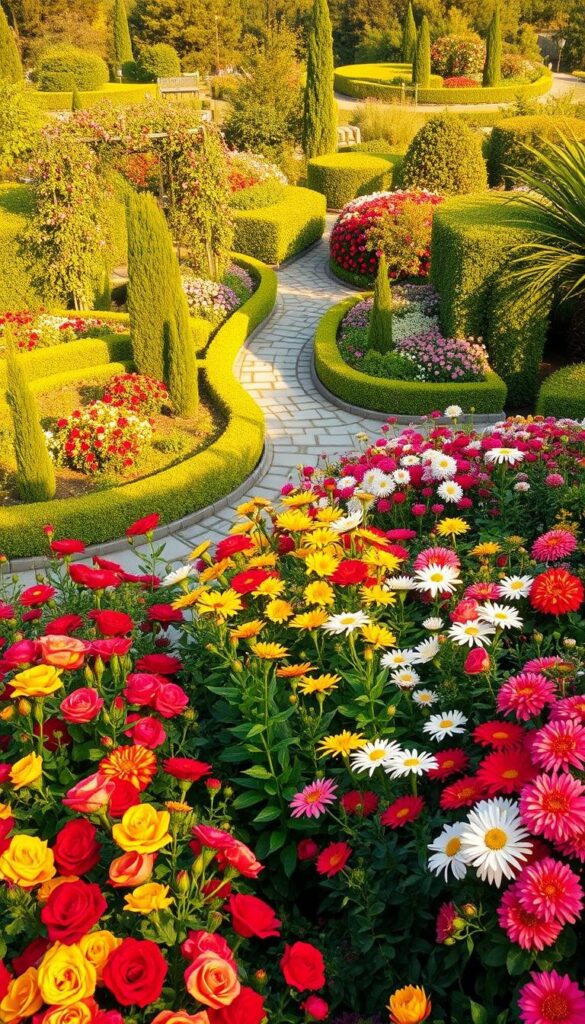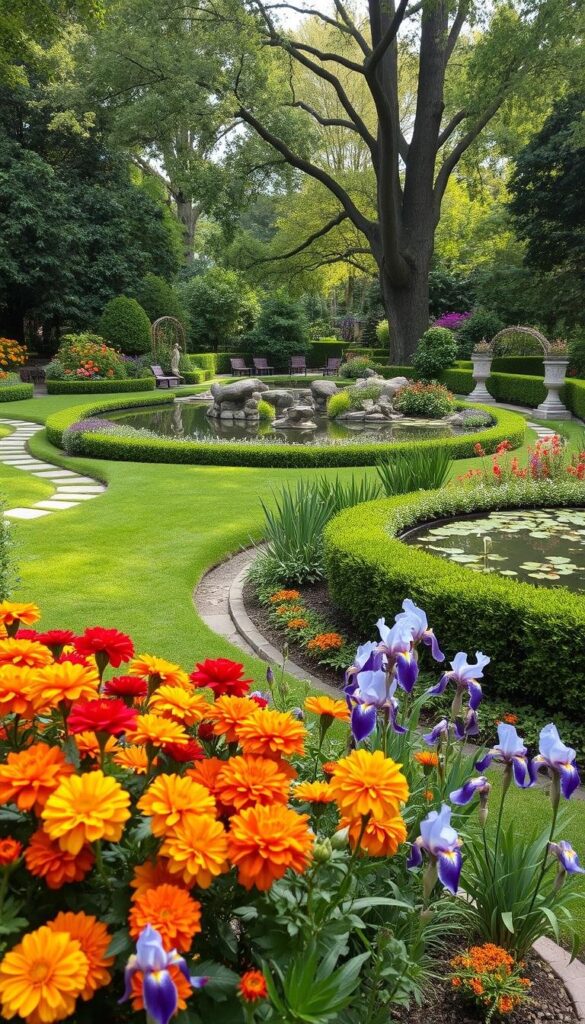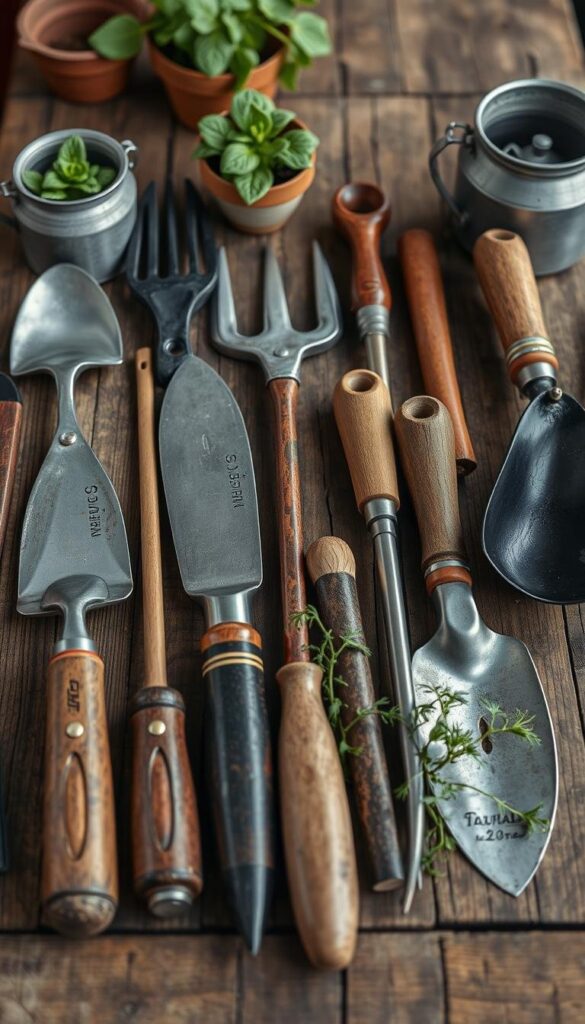This post may contain affiliate links. If you click and buy, we may earn a small commission at no extra cost to you. Learn more.
Step into a world where colors burst and scents dance. A floral garden is more than plants—it’s a living masterpiece. Whether you’re a seasoned gardener or just starting, these blooming gardens offer peace and beauty.
Imagine walking through pathways surrounded by roses, tulips, and sunflowers. Each bloom tells a story of care and nature’s artistry.
Every season brings new life to a floral garden. Spring’s first blossoms, summer’s vibrant displays, and autumn’s golden hues create year-round charm. These gardens also support bees and butterflies, making them vital for ecosystems.
This guide will help you design, maintain, and enjoy your own slice of floral wonder. Let’s begin your journey to a thriving, joyful garden.
Contents
- 1 What is a Floral Garden?
- 2 Types of Floral Gardens
- 3 Planning Your Floral Garden
- 4 Essential Tools for Gardeners
- 5 Seasonal Considerations for Floral Gardens
- 6 Attracting Wildlife to Your Floral Garden
- 7 Sustainable Gardening Practices
- 8 Floral Garden Design Ideas
- 9 Hosting Events in Your Floral Garden
- 10 Community Floral Gardens
- 11 Visiting Notable Floral Gardens
What is a Floral Garden?
Imagine a space full of vibrant colors and fragrant blooms. A floral garden celebrates flowers as the main attraction. Unlike botanical gardens, these spaces focus on beauty and biodiversity.
They feature everything from cottage-style blooms to geometric patterns. Each element showcases nature’s beauty.

Definition and Characteristics
Floral gardens are all about variety. They have:
- A mix of annuals and perennials for color all year
- Thoughtful layouts that guide visitors through the seasons
- Use of colors and textures to create harmony
Importance of Floral Gardens
“Floral gardens connect people to nature’s rhythms in a way few other spaces can.”
These spaces are like outdoor classrooms. They teach about plant biology and art. They also serve as community hubs, promoting relaxation and creativity.
Publicbotanical gardens often expand this role. They host educational programs or conservation initiatives.
Benefits to Local Ecosystems
Floral gardens help wildlife by:
- Providing nectar for pollinators like bees and butterflies
- Reducing urban heat with shaded plantings
- Encouraging native species that stabilize soil and attract birds
Every bloom helps create a healthier environment. This shows that beauty and function can go together.
Types of Floral Gardens
Floral design and garden landscaping open up endless possibilities. They can change outdoor spaces in amazing ways. Here are three unique styles for different tastes and climates:

Traditional Flower Gardens
Classic floral design is perfect for traditional gardens. English cottage gardens are full of mixed flowers like roses and lavender. Formal gardens have flowers arranged in neat patterns.
Cutting gardens focus on bright flowers for bouquets. They use peonies or sunflowers. These styles mix beauty with structure in a timeless way.
Butterfly Gardens
Butterfly gardens welcome wildlife. Plant milkweed, coneflowers, and butterfly bushes to attract them. Add flat stones for butterflies to sunbathe and shallow water sources.
These gardens help pollinators and add color as butterflies move between flowers.
Xeriscape Floral Gardens
Xeriscape gardens are great for dry areas. They use plants like yarrow, sage, and desert marigolds that need little water. Mulch helps keep moisture in, and drip irrigation saves water.
This style shows you can have beauty without using a lot of water in garden landscaping.
Planning Your Floral Garden
Turning your yard into a beautiful floral garden begins with careful planning. Whether you’re new to gardening or have experience, these steps will help. They ensure your garden landscaping is a welcoming outdoor garden display all year. Here’s how to start:
Choosing the Right Location

- 6-8 hours of sunlight (most flowers need this)
- Well-drained soil—test by digging a hole, fill with water, and see if it drains in 4 hours
- Accessibility for maintenance tools and easy viewing angles
Selecting the Perfect Flowers
First, match plants to your USDA hardiness zone. Check the USDA’s zone map to find your area. Then, mix different types for a balanced look:
- Color harmony: Pair warm hues (red, orange) with cool tones (blue, purple) for contrast
- Bloom timelines: Choose early, mid, and late-season flowers for continuous color
- Height layers: Place tall flowers like sunflowers at the back, spreading varieties like marigolds in mid-range, and low-growing thymes at edges
Designing for Seasonal Blooms
Keep your garden colorful all year. Use:
- Evergreens as structural anchors
- Spring bulbs (tulips, daffodils) for early color
- Fall mums and witch hazel for late-season interest
A well-planned design balances beauty and function. Start small, test soil pH, and adjust as your garden grows!
Essential Tools for Gardeners
Every successful floral garden starts with the right tools. From digging to trimming, the right equipment makes gardening easier. It also enhances your garden decor. Let’s explore what every gardener needs to grow a thriving outdoor space.

Must-Have Gardening Tools
Start with basics like trowels, pruners, and gloves. A sturdy watering can or hose nozzle keeps plants hydrated. Don’t forget decorative touches—colorful pots or wrought-iron trellises add both function and flair to your garden decor.
- Trowels for planting and weeding
- Pruners for shaping shrubs and flowers
- Wheelbarrows for moving soil and mulch
Tips for Maintenance
Regular care keeps gardens vibrant. Water early in the morning to reduce evaporation. Mulch around plants to retain moisture and suppress weeds.
Fertilize according to plant needs, and inspect leaves weekly for pests. A well-maintained garden becomes a beautiful garden decor masterpiece.
Eco-Friendly Gardening Solutions
Embrace sustainability with compost bins to recycle kitchen scraps. Use neem oil or insecticidal soap for pest control. Drip irrigation systems save water while nourishing roots.
Even small steps like solar-powered garden lights add eco-friendly garden decor that’s kind to the planet.
Seasonal Considerations for Floral Gardens
Seasons change, bringing new chances and challenges to your blooming garden. Adjusting your care helps plants grow all year. Plan for spring, care for summer blooms, and rest for winter. Here’s how to make every season special:
Spring Planting Strategies
Spring’s mild weather starts growth. Follow these steps:
- Plant bulbs (tulips, daffodils) in early spring for summer blooms.
- Amend soil with compost to fuel new blooming garden growth.
- Watch for aphids—use neem oil sprays for eco-friendly pest control.
Summer Care Practices
Beat summer’s heat with smart care:
- Water deeply but infrequently to encourage deep root growth.
- Deadhead spent blooms weekly to extend flowering cycles.
- Shield plants from scorching sun with shade cloths during heatwaves.
Preparing for Fall and Winter
End the season with proactive steps:
Divide overcrowded perennials in fall. Plant spring-flowering bulbs like crocus for next year’s color. Mulch beds with shredded leaves to insulate roots. Leave seed heads on plants like coneflower to feed birds—this adds winter interest to your blooming garden.
“A well-tended garden thrives when you work with the seasons, not against them.”
Adjust tools like soaker hoses for efficient watering. Consider winterizing with frost cloths. Every season’s care makes your outdoor space vibrant and resilient.
Attracting Wildlife to Your Floral Garden
Turn your garden into a lively home for wildlife. Invite birds, pollinators, and beneficial insects to make your space more diverse and beautiful. Every part of your garden, from plants to layout, helps create a thriving ecosystem.

Beneficial Pollinators
Bees, butterflies, and hummingbirds need flowers for food. Plant nectar-rich flowers like lavender, salvia, and echinacea. Group plants together to help pollinators find their way. Use organic pest control to keep them safe.
Creating a Bird-Friendly Environment
- Install feeders with sunflower seeds or suet in shaded spots.
- Provide water sources like shallow birdbaths or small ponds.
- Use plants of different heights—tall shrubs for nesting, groundcovers for cover.
How to Include Beneficial Insects
Predatory insects like ladybugs and lacewings keep pests in check. Add herbs like dill or fennel for pollen and shelter. Leave small piles of leaves or mulch as homes—these mimic natural habitats without harming your garden.
By combining these elements, your garden becomes a haven for wildlife. Watch as birds and butterflies enjoy your garden, showing that a well-designed outdoor space benefits both nature and you.
Sustainable Gardening Practices

Keeping a floral garden sustainable means caring for its beauty and the environment. These habits help plants and the planet. Let’s explore ways to make your garden grow responsibly.
Composting in Your Floral Garden
Composting turns kitchen waste and yard clippings into soil full of nutrients. Begin by gathering fruit peels, leaves, and grass. A simple bin or pile is enough for small areas.
Turn the materials every week. Then, use the compost to make your soil better. “Compost feeds the soil, not just the plants,” gardening experts say. This method reduces waste and improves plant health.
Organic Pest Control Methods
- Use neem oil or insecticidal soap to target pests without chemicals.
- Plant marigolds or basil to deter insects naturally.
- Introduce ladybugs or praying mantises to control harmful insects.
Water Conservation Techniques
Smart watering keeps your garden looking great with less water. Use drip irrigation to water roots directly. Mulch helps keep moisture in the soil.
Collect rainwater in barrels during storms. Choose native plants that need less water. These steps save water and resources.
Floral Garden Design Ideas
Make your outdoor area lively with creative garden decor and fresh flower arrangements. Even a small yard or balcony can become a vibrant oasis with these tips.
Vertical Gardening Inspirations
Save space and add drama with vertical designs:
- Install wall-mounted planters for cascading blooms like petunias or ivy.
- Use trellises to train climbing roses or clematis along fences.
- Hang suspended planters from pergolas to create floating displays.
Container Planting Solutions
Containers bring flexibility and color to garden decor. Mix these elements:
- Layer trailing plants like lobelia with upright flowers in tall pots.
- Repurpose items—old wheelbarrows or rain boots—into unexpected planters.
- Pair succulents with bright annuals for low-maintenance arrangements.
Use of Native Plants in Design
“Native plants are nature’s blueprint for beauty,” says Flower & Garden Magazine.
Integrate regional species like coneflowers or milkweed to:
- Support local pollinators without extra watering.
- Create cohesive groupings that thrive in your climate.
- Partner with brands like Native Plant Society for expert selections.
Blend these ideas to craft a garden that’s both beautiful and sustainable—no matter your space or skill level.
Hosting Events in Your Floral Garden
Make your floral garden a place for friends and family to gather. With some planning, even small areas can host memorable events. First, look at your garden’s layout to make spaces that are inviting and useful.
Tips for Outdoor Gatherings
- Place seating near key spots like flower beds or paths.
- Use string lights or solar path markers to help guests find their way.
- Have a tent or shaded area ready for unexpected weather.
Creating a Relaxing Ambiance
Add things that catch the senses. Put wind chimes near tall grasses and a small water feature for calming sounds. Use fairy lights that turn on when someone moves to show off flower displays without being too much.
Floral Arrangements for Events
Pick flowers for flower bouquets and centerpieces two days before your event. Cut stems in the morning when they’re most full of water. For flower arrangements, mix big flowers with simple leaves to keep the garden’s beauty in focus.
“A well-placed hydrangea arrangement near the entrance creates an instant wow factor,” says garden designer Emily Carter.
Set up seating so guests can enjoy the flowers and each other. With these tips, your garden will be a place of beauty, comfort, and celebration.
Community Floral Gardens
Community floral gardens turn empty lots into lively spots where neighbors work together. They often team up with local botanical gardens for workshops and tips. This teamwork makes neighborhoods more beautiful and builds friendships.
These gardens are great for learning and making friends. They:
- Promote teamwork through group planting projects
- Provide education on native plants via partnerships with botanical gardens
- Encourage diverse participation across ages and backgrounds
“Planting together, we’ve turned a forgotten lot into a place everyone loves,” said Maria Lopez, a Chicago community gardener.
How to Join or Start a Garden
- Search local parks departments for shared garden programs
- Contact botanical gardens like the Chicago Botanic Garden for volunteer opportunities
- Form a committee to approach city officials for land use
Inspiration from Successful Gardens
Seattle’s P-Patch Community Gardens has 80+ plots run by residents. In Detroit, the Greening of Detroit turned empty lots into gardens. These examples show how working together can make a big difference.
Visiting Notable Floral Gardens
Exploring botanical gardens across the country can broaden your floral knowledge. These gardens serve as living museums, inspiring and educating gardeners of all levels.
Iconic Botanical Gardens in the U.S.
The New York Botanical Garden in the Bronx is a landmark with vast collections and historic buildings. Longwood Gardens in Pennsylvania dazzles with its year-round flowers. The Portland Japanese Garden in Oregon combines tradition with horticulture excellence. Each garden hosts seasonal events, guided tours, and unique plant collections.
Hidden Gems in Local Communities
Arizona’s Desert Botanical Garden is a hidden treasure, home to cacti and desert flowers. Seattle’s Elisabeth C. Miller Library offers urban oasis insights. Florida’s Marie Selby Botanical Gardens showcase tropical plants. These gardens often feature local plants and community programs.
What to Expect During Your Visit
Check the official websites for the best times to visit. Bring a camera to capture the beauty. Attend workshops on pruning or native plants. Many gardens have seed swap events for exchanging plants and tips. These experiences can inspire your garden’s seasonal changes or pollinator-friendly designs.
To bring you cozy inspiration more efficiently, we sometimes use AI to assist in content creation — but every word and idea is carefully shaped by our team. See our AI Disclosure for more info.







